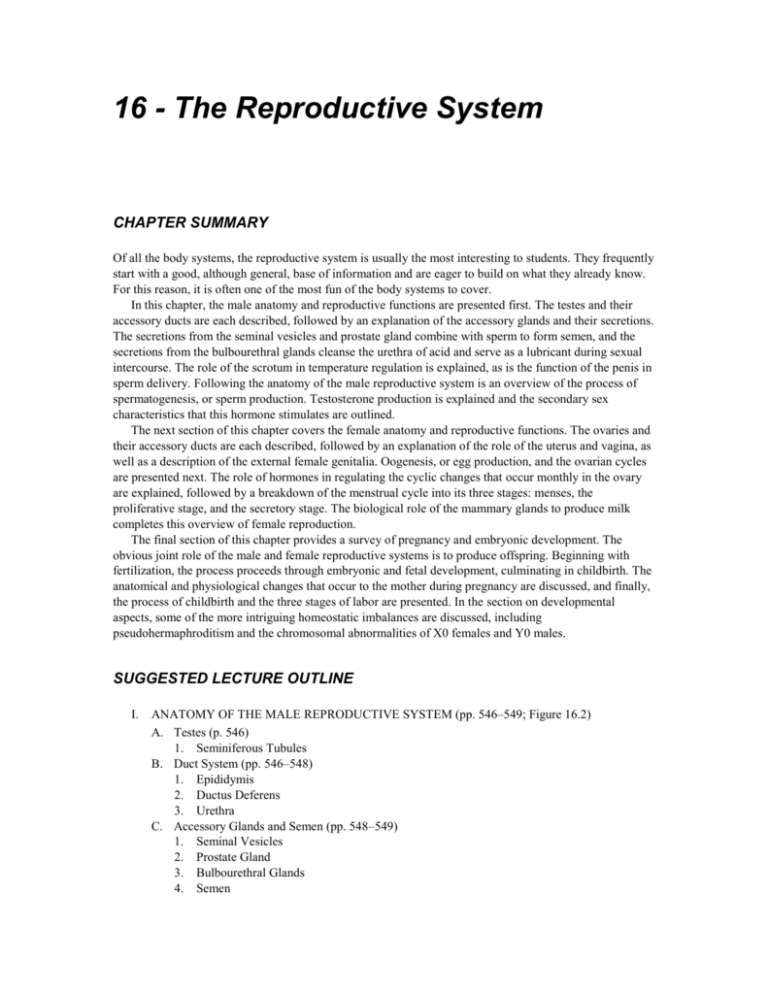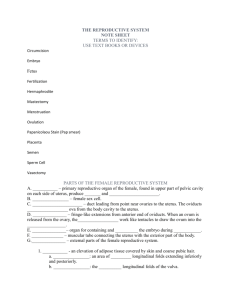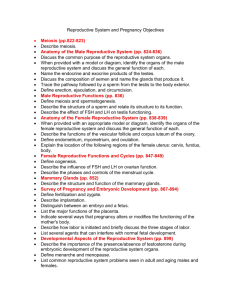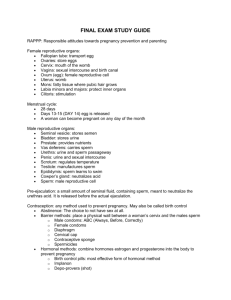16 - The Reproductive System
advertisement

16 - The Reproductive System CHAPTER SUMMARY Of all the body systems, the reproductive system is usually the most interesting to students. They frequently start with a good, although general, base of information and are eager to build on what they already know. For this reason, it is often one of the most fun of the body systems to cover. In this chapter, the male anatomy and reproductive functions are presented first. The testes and their accessory ducts are each described, followed by an explanation of the accessory glands and their secretions. The secretions from the seminal vesicles and prostate gland combine with sperm to form semen, and the secretions from the bulbourethral glands cleanse the urethra of acid and serve as a lubricant during sexual intercourse. The role of the scrotum in temperature regulation is explained, as is the function of the penis in sperm delivery. Following the anatomy of the male reproductive system is an overview of the process of spermatogenesis, or sperm production. Testosterone production is explained and the secondary sex characteristics that this hormone stimulates are outlined. The next section of this chapter covers the female anatomy and reproductive functions. The ovaries and their accessory ducts are each described, followed by an explanation of the role of the uterus and vagina, as well as a description of the external female genitalia. Oogenesis, or egg production, and the ovarian cycles are presented next. The role of hormones in regulating the cyclic changes that occur monthly in the ovary are explained, followed by a breakdown of the menstrual cycle into its three stages: menses, the proliferative stage, and the secretory stage. The biological role of the mammary glands to produce milk completes this overview of female reproduction. The final section of this chapter provides a survey of pregnancy and embryonic development. The obvious joint role of the male and female reproductive systems is to produce offspring. Beginning with fertilization, the process proceeds through embryonic and fetal development, culminating in childbirth. The anatomical and physiological changes that occur to the mother during pregnancy are discussed, and finally, the process of childbirth and the three stages of labor are presented. In the section on developmental aspects, some of the more intriguing homeostatic imbalances are discussed, including pseudohermaphroditism and the chromosomal abnormalities of X0 females and Y0 males. SUGGESTED LECTURE OUTLINE I. ANATOMY OF THE MALE REPRODUCTIVE SYSTEM (pp. 546–549; Figure 16.2) A. Testes (p. 546) 1. Seminiferous Tubules B. Duct System (pp. 546–548) 1. Epididymis 2. Ductus Deferens 3. Urethra C. Accessory Glands and Semen (pp. 548–549) 1. Seminal Vesicles 2. Prostate Gland 3. Bulbourethral Glands 4. Semen D. External Genitalia (p. 549) 1. Scrotum 2. Penis II. B. III. MALE REPRODUCTIVE FUNCTIONS (pp. 550–553) A. Spermatogenesis (pp. 550–552) Testosterone Production (pp. 552–553) ANATOMY OF THE FEMALE REPRODUCTIVE SYSTEM (pp. 552–557; Figure 16.8) A. Ovaries (pp. 553–554) 1. Follicles 2. Corpus Luteum B. Duct System (pp. 554–556) 1. Uterine (Fallopian) Tubes 2. Uterus 3. Vagina C. External Genitalia (pp. 556–557) 1. Labia Majora and Minora 2. Clitoris IV.FEMALE REPRODUCTIVE FUNCTIONS AND CYCLES (pp. 557–561) A. Oogenesis and the Ovarian Cycle (pp. 557–559) B. Uterine (Menstrual) Cycle (pp. 559–561) 1. Days 1–5: Menstrual Phase 2. Days 6–14: Proliferative Phase 3. Days 15–28: Secretory Phase C. Hormone Production by the Ovaries (p. 561) 1. Estrogens 2. Progesterone V.MAMMARY GLANDS (pp. 561–563) A. Lactation B. Mammography VI.SURVEY OF PREGNANCY AND EMBRYONIC DEVELOPMENT (pp. 563–571) A. Accomplishing Fertilization (pp. 563–564) 1. Zygote B. Events of Embryonic and Fetal Development (pp. 565–566) 1. Cleavage 2. Embryo 3. Blastocyst 4. Trophoblast 5. Germ Layers 6. Placenta 7. Fetus C. Effects of Pregnancy on the Mother (pp. 566–569) 1. Anatomical Changes 2. Physiological Changes a. Gastrointestinal System b. Urinary System c. Respiratory System d. Cardiovascular System D. Childbirth (pp. 569–571) 1. 2. Initiation of Labor Stages of Labor a. Stage 1: Dilation Stage b. Stage 2: Expulsion Stage c. Stage 3: Placental Stage VII.DEVELOPMENTAL ASPECTS OF THE REPRODUCTIVE SYSTEM (pp. 572–578) A. Chromosomes B. Puberty C. Menarche D. Contraception (A Closer Look) E. Menopause TEACHING TIP Outline spermatogenesis and oogenesis together to help students understand their similarities as well as differences. MEDIA TIP Gender Biology: Men and Women Really Are Different (FHS; 22 min., 2001). This program explores the emerging field of gender-based biology and gender implications in medical treatments. KEY TERMS accessory reproductive organs acrosome afterbirth alveolar glands amnion ampulla areola blastocyst body broad ligament bulbourethral glands cervix chorionic vesicle chorionic villi cleavage clitoris corpus luteum dilation stage ductus deferens ectoderm ejaculation ejaculatory duct embryo endoderm endometrium epididymis erectile tissue erection estrogens expulsion stage external genitalia fallopian tubes false labor fertilization fetus fimbriae follicle cells foreskin fundus gametes glans penis gonads Graafian follicle greater vestibular glands human chorionic gonadotropin (hCG) hymen implantation inner cell mass labia majora labia minora labor lactating lactiferous ducts luteinizing hormone (LH) mammary glands meiosis membranous urethra menarche menopause menstrual cycle mesoderm mons pubis myometrium nipple oocyte oogenesis oogonia ova ovarian cycle ovarian follicles ovarian ligaments ovaries ovulation ovum parturition penis perimetrium perineum placenta placental stage polar body pregnancy prepuce primary oocytes primary sex organs primary spermatocyte progesterone prostate prostatic urethra puberty relaxin reproductive system round ligament scrotum secondary oocyte secondary sex characteristics semen seminal vesicles seminiferous tubules shaft sperm spermatic cord spermatids spermatogenesis spermatogonia spermiogenesis spongy (penile) urethra suspensory ligaments testosterone trophoblast umbilical cord urethra uterine cycle uterine tubes uterosacral ligament uterus vagina vas deferens vesicular follicle vestibule vulva zygote LECTURE HINTS 1. Remind students that the male reproductive system shares structures with the urinary system, whereas the female reproductive system does not. Point out that this difference is evident even during embryonic development. Key point: This point may seem obvious, but it is surprising to learn how many people actually don’t realize this key concept. 2. Point out that development of the testes within the abdominal cavity is similar to development of the ovaries, but that the testes descend into the scrotum for temperature control of sperm, usually prior to birth. Cryptorchidism, or undescended testes, is a condition that can lead to sterility unless surgically corrected. Explain why hot tubs could be considered a form of male birth control. Key point: The asymmetry of this system is often confusing for students at first. 3. Discuss the conditions of hypospadias and epispadias and their consequences. Key point: Hypospadias is the opening of the urethra on the undersurface of the penis, whereas epispadias is the opening of the urethra on the dorsal surface. Depending on severity, both conditions can decrease male fertility by causing inadequate deposition of sperm, and both are usually corrected surgically. 4. Clearly itemize the components of semen. Key point: Students frequently think semen and sperm are synonymous and are surprised to learn that semen is a combination of several secretions. 5. Discuss prostatic cancer and benign prostatic hypertrophy (BPH), and differentiate between their signs, symptoms, and treatment options. Key point: BPH is common in men over 50 and results in urinary urgency, frequency, bladder infection, and other urinary difficulties. The hypertrophied prostatic tissue that is strangling the urethra is often removed surgically, or newer treatments, including drugs and radiation, can be used to shrink the enlarged tissue. Prostatic cancer is the third most common cancer in males, and incidences of this cancer are on the rise. Early detection is important and PSA (prostate-specific antigen) is becoming a common screening tool. 6. Outline spermatogenesis and oogenesis together to help students understand their similarities as well as differences. Key point: This is a good opportunity to emphasize the differences between mitosis and meiosis. 7. Itemize the secondary sex characteristics of both males and females. Remind students of the role of hormones in sexual development, and discuss the effects of homeostatic imbalances of these hormones. Key point: This becomes a good point of discussion since there is increasing scientific concern over the exposure of both males and females to synthetic estrogens from plastics and pesticides. 8. Note that the layers of the uterus follow a pattern of layering we have seen with other organs and tissues. Also point out that the cervix refers to the “neck” of the uterus, to differentiate it from cervical vertebrae found in the actual neck region. Key point: The endometrium, myometrium, and perimetrium follow a pattern seen with such organs as the heart and nerves. Recognizing this pattern helps students better visualize the layers. Recognizing root word meanings, such as “cervix,” helps explain why it can be used in reference to entirely different regions. 9. Discuss the incidences of cervical, uterine, ovarian, and breast cancer in women, as well as screening tools and treatment options. Key point: An annual Pap smear is the screening tool of choice for early detection of cervical cancer. Breast cancer is the leading cause of death in American women and screening includes monthly selfexamination and annual mammography for certain age groups. Early detection of uterine or ovarian cancer is still unsatisfactory. 10. Outline the process of fertilization and follow the path of the fertilized egg from conception to implantation. Discuss ectopic pregnancy and placenta previa. Key point: Students are usually quite interested in the fertilization process and have often heard of complications that can arise. Explaining that fertilization generally takes place in the fallopian tubes helps explain the incidence of ectopic pregnancy, and implantation close to the cervical opening explains the seriousness of placenta previa. 11. Review the stages of the menstrual cycle (and note the correct spelling of menstruation, since many people are unaware of the “u”). Key point: Both males and females are frequently unsure of the menstrual stages but are often too embarrassed to admit that they don’t know about such a common, normal part of female life. 12. Explain how birth control pills work to prevent pregnancy. Key point: Describe how these synthetic hormones “trick” the body into thinking it is pregnant, thereby stopping ovulation and preventing pregnancy. 13. Clearly differentiate between the terms prostate and prostrate, and between perineum and peritoneum. Key point: These terms are often used incorrectly by students and laypersons in general. 14. Explain some of the genetic conditions associated with chromosomal abnormalities, such as Down and Turner’s syndrome. Remind the students of previous discussions about x-linked disorders such as hemophilia and choroideremia. Key point: This is an excellent opportunity to give a brief overview of some of the more prominent or intriguing hereditary conditions. 15. Describe eclampsia, or toxemia of pregnancy, and discuss early detection and treatment. Key point: Eclampsia, the most serious complication of pregnancy, is a severe hypertensive disorder characterized by convulsions and coma, which can lead to death. Early detection is critical, and the primary means of early detection is through urine testing for proteinuria, an excellent early sign of increasing blood pressure. Treatment involves bedrest and seizure management. 16. Discuss the different types of birth control methods. Explain the efficacy and side effects of each. Key point: Students may be aware of only one or two methods, and may not understand how they actually prevent contraception. 17. Explain the term miscarriage and contrast it with abortion. Describe the potential causes of miscarriage, including exposure to various household chemicals and toxins. Key point: Many students do not realize that they could have actually “miscarried” a pregnancy and not have known it if it did not implant in the uterus. Many students are also unaware of the impacts of exposure to many common chemicals during pregnancy. TRANSPARENCIES/MEDIA MANAGER INDEX Figure 16.1 Sagittal section of the testis and associated epididymis Figure 16.2 Male reproductive organs Figure 16.3 Spermatogenesis Figure 16.4 The human life cycle Figure 16.5 Structure of sperm Figure 16.6 Hormonal control of the testis Figure 16.7 Sagittal view of a human ovary showing the developmental stages of an ovarian follicle Figure 16.8 The human female reproductive organs Figure 16.9 External genitalia of the human female Figure 16.10 Events of oogenesis Figure 16.11 Ovulation Figure 16.12 Hormonal interactions of the female cycles Figure 16.13 Female mammary glands Figure 16.14 Mammograms Figure 16.15 Cleavage is a rapid series of mitotic divisions that begins with the zygote and ends with the blastocyst Figure 16.16 Embryo of approximately 18 days Figure 16.17 The 7-week embryo Figure 16.18 Photographs of developing fetus Figure 16.19 The positive feedback mechanism by which oxytocin promotes labor contractions during birth Figure 16.20 The three stages of labor Table 16.1 Development of the Human Fetus A Closer Look Contraception: Preventing Pregnancy Focus on Careers Doula* Systems in Sync Homeostatic Relationships Between the Reproductive System and Other Body Systems *Indicates images that are on the Media Manager only. ANSWERS TO END OF CHAPTER REVIEW QUESTIONS Questions appear on pp. 580–582 Multiple Choice 1. d (p. 548) 2. a (pp. 556–557) 3. d (p. 556) 4. d (pp. 552, 559–561) 5. b (p. 557) 6. b, c, d (p. 554) 7. d (p. 551) 8. a (pp. 555–556) 9. c (pp. 557–559) 10. b (pp. 553–554) 11. d (p. 565) 12. a, d (p. 570) 13. a, d (Table 16.1) Short Answer Essay 14. The testes are the male gonads. They form sperm and testosterone. (p. 546) 15. To provide a liquid medium for carrying sperm out of the male body and into the female reproductive tract. Prostate gland, seminal vesicles, and bulbourethral glands. (pp. 548–549) 16. Erection. (p. 549) 17. Ejaculation: Propulsion of sperm (in seminal fluid) out of the male’s body. (p. 548) 18. Internal body temperature is too high for the production of viable human sperm. The lower temperature that is required is provided for by the testes being housed in the scrotum, a divided skin sac that hangs outside the body cavity, posterior to the penis. (p. 549) 19. Hypertrophy of the prostate gland, which surrounds the urethra, constricts the urethral passageway, thus inhibiting the passage of semen. (pp. 548–549; Figure 16.2) 20. Spermatogenesis begins during puberty under the influence of FSH from the anterior pituitary. LH (another anterior pituitary hormone) causes the testes to produce testosterone at that time. Testosterone is also necessary for normal sperm production. (pp. 550, 552) 21. Increased hair growth all over the body and particularly on the face, axillary and pubic regions; deepening of the voice; enlargement of the skeletal muscles; thickening of the bones. (p. 552) 22. Testosterone is still produced and secondary sex characteristics and sex drive are retained after a vasectomy. Sperm are still produced but cannot reach the body surface after this relatively minor procedure. (p. 548) 23. The ovary. It produces eggs (actually oocytes) and the female sex hormones estrogen and progesterone. (pp. 553–554) 24. The term urogenital system is more applicable to males because their urinary and reproductive systems share some of the same pathways. (p. 548) 25. Uterine (Fallopian) tubes: The usual site of fertilization; conduct the oocyte (or embryo) to the uterus. Uterus: The site of implantation of the embryo. Vagina: The birth canal and the chamber through which menstrual flow leaves the body. (pp. 554–556) 26. The distal ends of the uterine tubes have fingerlike extensions called fimbriae, which wave and create fluid currents to draw the ovulated body into the uterine tube. (p. 554–555) 27. Follicle: An immature egg (oocyte) surrounded by one or more layers of smaller cells called follicle cells. Ovulation: Ejection of an oocyte (surrounded by a capsule of follicle cells) from the ovary. (p. 553) 28. The human oocyte becomes an ovum only if sperm penetration occurs, at which time the secondary oocyte completes the second meiotic division to produce the ovum nucleus and a polar body, which is ejected. (pp. 553, 557–558) 29. Both growing and mature (Graafian) ovarian follicles form estrogen. The second hormone produced by the ovary is progesterone. (p. 561) 30. See pp. 559–561 of the text. It provides the uterine environment needed for implantation. 31. Menopause: The period during which a woman’s ovarian function (thus, reproductive ability) gradually declines and finally ends. (p. 576) 32. Fertilization: Fusion of the sperm and egg nuclei to form the nucleus of the fertilized egg, or zygote. It normally occurs in the uterine tube of the female. Implantation involves the erosion of the uterine mucosa by the embryo, and then the covering over of the embedded embryo by mucosa regrowth. (pp. 563–565) 33. During pregnancy the woman’s respiratory and urinary systems must function “for two.” Respiration becomes increasingly difficult as the uterus enlarges and presses the abdominal organs superiorly against the diaphragm. Cardiac output and blood pressure also increase to meet the increased circulatory demands. Changes in the woman’s weight distribution and center of gravity make walking more difficult and lead to muscle strain. Urinary frequency sometimes occurs as the uterus presses on the bladder. (pp. 566–568) 34. Estrogens reach their highest levels in the mother’s blood, which leads to weak uterine contractions. Certain cells of the fetus begin to produce oxytocin, along with the mother’s hypothalamus. Prostaglandins released by the placenta also stimulate more frequent and powerful uterine contractions. (pp. 569–570) 35. During stage 2 (expulsion stage). (p. 570) 36. The indifferent stage occurs up until eight weeks of embryonic development. During this time, the reproductive structures of the male and female embryos cannot be differentiated. (p. 571) 37. The major events of puberty in males include enlargement of testes and scrotum; appearance of pubic, axillary, and facial hair; penis growth; and the presence of mature sperm in semen. In females, the major events of puberty include breast development and menarche. (p. 573) 38. Except for prostatic hypertrophy, aging males seem to have few age-associated reproductive system problems. Reproductive capacity in females ends during menopause. Problems associated with the relative lack of female hormones after menopause include high blood pressure, bone loss, and predisposition to vaginal infections. (pp. 576, 578) ANSWERS TO CRITICAL THINKING AND CLINICAL APPLICATION QUESTIONS 39. The woman is in the second, or expulsion, stage of labor. Since this stage typically takes 50 minutes for the first birth and 20 minutes in subsequent births, she probably would not have time to get to the hospital. (p. 570) 40. It is possible for an oocyte to be ovulated from a right ovary into the peritoneal cavity, and then move through the fluid of the peritoneal cavity all the way to the infundibulum of the left uterine tube. Several cases have been documented of women like Lucy bearing children. (pp. 554–555) 41. The mucus produced by these glands cleans the urethra of urine residues. (p. 549) 42. Her only options are coitus interruptus, or withdrawal of the penis just before ejaculation, or rhythm or fertility awareness methods, based on recognizing the period of ovulation or fertility and avoiding intercourse during those intervals. (pp. 574–576) 43. Ibuprofen is a prostaglandin inhibitor; such drugs can inhibit labor in the early stages. (p. 570) 44. Castration would prevent the development of secondary sex characteristics, which includes deepening of the voice due to enlargement of the larynx. (p. 552) 45. Polar bodies have essentially no cytoplasm so they deteriorate and die quickly. (p. 559) CLASSROOM DEMONSTRATIONS AND STUDENT ACTIVITIES Classroom Demonstrations 1. Film(s) or other media of choice. 2. Use a dissectible human torso model to demonstrate the location of the reproductive organs. 3. If available, use a “pregnant” torso model to illustrate the most desirable positioning of the placenta and the vertex presentation of a fetus along with the placement of fetuses during a multiple pregnancy. 4. Use models showing the process of meiosis in spermatogenesis and oogenesis. 5. Use embryonic-fetal development models to show the stage of cleavage, the blastula, etc. 6. If available, show preserved specimens of human embryos or fetuses in various stages of development to illustrate the later changes that occur during gestation. 7. Invite a speaker from the local public health department to present the most current information on STDs. 8. Invite a nurse from the local hospital labor and delivery department to talk about childbirth from their perspective. 9. Form a panel of women who have gone through pregnancy and childbirth and ask them to discuss their experiences with the class. 10. Invite a midwife or doula to speak to the class on their role in the delivery process. 11. Invite a genetic counselor to speak to the class on the role of genetic counseling in family planning. Student Activities 1. Have students find and bring in articles that deal with the effects of maternal drug use or alcoholism on the fetus. Use this information as a starting point for class discussion, including a discussion of fetal alcohol syndrome. 2. Ask students to research sexually transmitted diseases and present their findings on the top five STDs in their local area compared to the national figures. 3. Provide diagrams of the reproductive system for students to label. 4. Display various types of contraceptive techniques as an adjunct to a discussion of birth control. 5. Have students participate in breast or prostatic cancer awareness activities, AIDS walks, or other activities relevant to the study of the reproductive system. 6. Have students research and report on advances in assisted fertilization as a starting point for class discussion. 7. Ask students to come to class prepared to talk about natural childbirth, home birthing, episiotomy, cesarean section, circumcision, and other topics related to childbirth. MULTIMEDIA See page 182 for a listing of media resources. 1. 1 + 1: A Natural History of Sexuality (FHS; 53 min., 2001, VHS, DVD). This program examines four billion years of history to find an answer to the question of why sex has evolved into the primary mode of procreation. 2. Birth: Eight Women’s Stories (FHS; 70 min., 1993, VHS). Gold medal winner, this video follows eight women giving birth in a variety of circumstances, including natural birth at home and induced vaginal delivery. 3. Boy or Girl? When Doctors Choose a Child’s Sex (FHS; 15 min., 1999, VHS, DVD). This video examines medical and ethical implications associated with sex assignment in cases of ambiguous genitalia. 4. BPH: Aging and the Enlarged Prostate (FHS; 23 min., 2001, VHS, DVD). This program examines the symptoms, medications, surgical interventions, and future treatment options for this common medical condition. 5. Gender Biology: Men and Women Really Are Different (FHS; 22 min., 2001, VHS, DVD). This program explores the emerging field of gender-based biology and gender implications in medical treatments. 6. A Human Life Emerges (FHS; 33 min., 1995, VHS, DVD). Part of a two-part series, this program presents a close-up view of reproduction from fertilization through gestation and culminating in birth. 7. The Human Female Reproductive System (UL; 29 min., 1997, VHS). This video describes the structures, functions, and hormones of the female reproductive system and examines selected homeostatic imbalances of the system. 8. The Human Male Reproductive System (UL; 29 min., 1997, VHS). This video describes the structures, functions, and hormones of the male reproductive system and examines selected homeostatic imbalances of the system. 9. A Question of Genes: Inherited Risks (FHS; 106 min., 1997, VHS, DVD). This program explores medical and ethical questions raised by genetic testing and future uses of genetic research. 10. Reproduction (FHS; 14 min., 1996, VHS, DVD). From The World of Living Organisms series, this program surveys various aspects of reproductive life, including contraception, STDs, and fertility. 11. Reproduction: Designer Babies (FHS; 20 min., 1995, VHS, DVD). From The New Living Body series, this program examines some of the issues raised by the potential uses and misuses of genetic technology. SOFTWARE 1. Genetics (FHS; Win/Mac). Investigates the basic principles of heredity, the history of genetics, clinical aspects of gene-related disorders, and ethical issues. 2. Meiosis (QUE; Win/Mac). Explains the process of meiosis.








